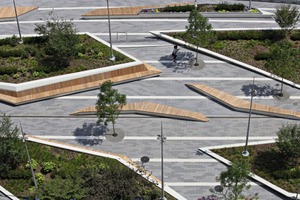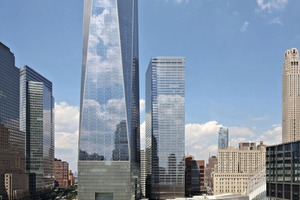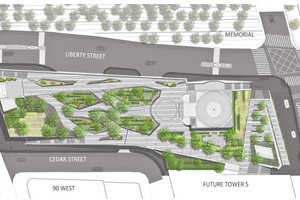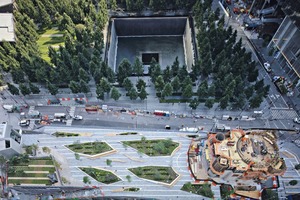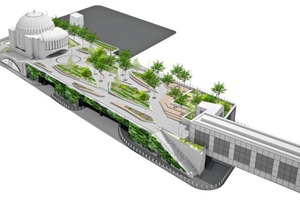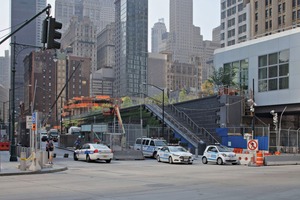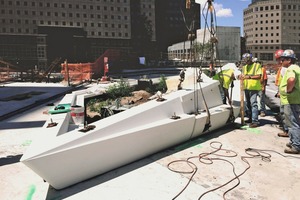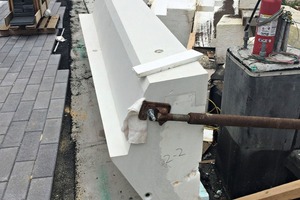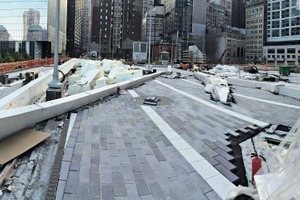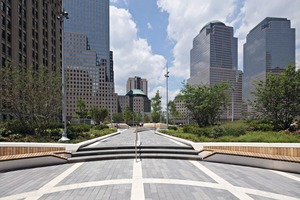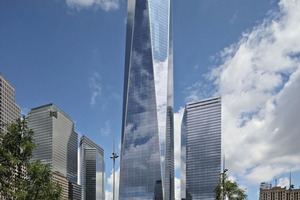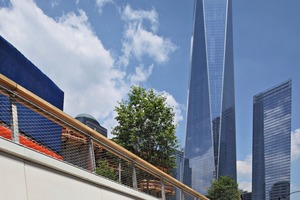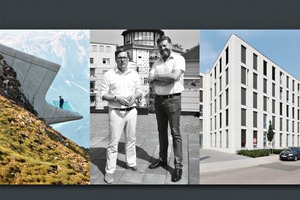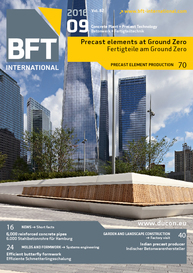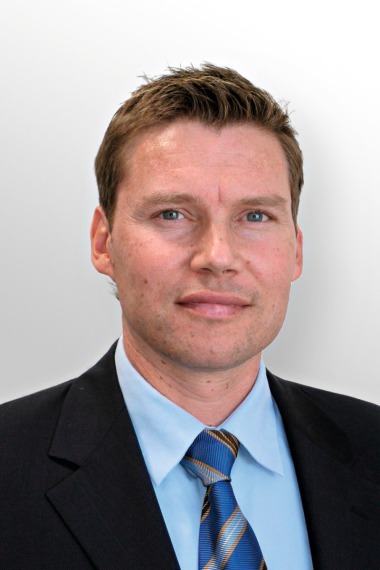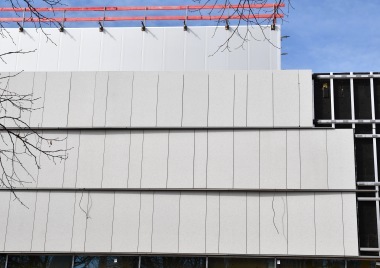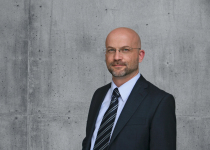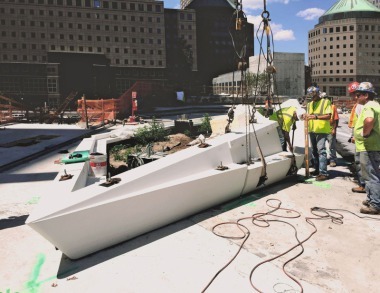Precast elements at Ground Zero [Video]
A single-story functional building forms the southern end of New York’s World Trade Center site. Its roof houses Liberty Park, a rooftop garden open to the public that features large-sized plant troughs produced from high-performance concrete.
Liberty Park is named after Liberty Street, an intersecting street of which only rudiments exist today and that is located in the immediate vicinity of the park. Its name does therefore not allude to the 9/11 attacks or to the fight for liberal democratic values. Even though this would seem logical, for Liberty Park is located atop a single-story functional building which forms the southern end of New York’s World Trade Center site and overlooks the 9/11 Memorial site.
The windowless building, which despite being single-storied is just under 10 m high, forms the logistics gateway to the entire World Trade Center site. It is a so-called VSC, a Vehicular Security Center that handles the entire logistics for the associated WTC buildings. Each vehicle, regardless of whether passenger car or truck, wishing to deliver goods to one of the surrounding skyscrapers or the Memorial Museum must enter here.
Car bomb proof
Similar to suitcases at an airport, vehicles entering the Vehicular Security Center are thoroughly scanned, then drive down an integrated ramp and pass into a spacious underground garage which feeds all related units.
As both the tunnel of New York’s Subway Line R and Cortlandt Street station are located in the immediate vicinity of the scanner unit and descent into the basement, these needed to be protected from the effects of the pressure generated by a car bomb exploding in the scanning zone. To achieve this goal, the basement walls and supports in question were lined with a micro-reinforced high-performance concrete supplied by German manufacturer Ducon. Its precast concrete elements are comprised of self-compacting fine-grained mortar with a highly ductile and therefore exceedingly flexible embedded steel reinforcement. These elements are extremely thin in relation to their performance (the wall elements used have a thickness of 10 cm but are capable of withstanding tank fire) and are installed at a specified distance from the wall to be protected. In the event of an explosion, the product destroys the kinetic energy by means of deformation, thus preventing the momentum being passed on to the subway tunnel. The Ducon technology offered an engineering solution combining extremely thin wall thicknesses with high protective action, thus ensuring effective protection of sensitive structural elements in restricted space conditions.
While the product offers high levels of explosion protection at standard wall thicknesses, precast concrete elements produced using Ducon can, on account of their ductility, be designed at reduced wall thicknesses and therefore extremely low weight. The Port Authority of New York and New Jersey, which owns the WTC site, made use of this advantage for the roof of the Vehicular Security Center.
A decade of planning
Gonzalo Cruz, Principal Architect at AECOM, inherited the project just under two years ago from Joe Brown, his predecessor who retired at that time. He calls Brown the chief designer for the urban development of the WTC site as AECOM is in charge of designing the entire urban-architectural infrastructure, which includes all pedestrian paths and streets outside the actual memorial site. Cruz can scarcely believe that for over ten years his firm has been working on a project covering less than 0.5 ha. The building underneath Liberty Park, which had been classified as secret, presented a major design problem. Whilst the roof structure did not require execution in supportless design, the security checkpoint was modified numerous times so that repeated corrections of the park design were necessary. For everything happening on the roof had to bow to security interests.
Building a supportless shoebox would have been the easiest solution but that was not what the designers intended to do. Right from the beginning, the idea was to use the landscape project to create a pedestrian connection between Cortlandt Street station and the Brookfield Place shopping mall. Vertical building walls would literally have “blocked” this idea. As a matter of fact, the first concept was modeled on a hill exhibiting two gently rising slopes – one dipping towards the southeast and the other facing north towards 9/11 Memorial Park.
Michael Arad, architect of the 9/11 Memorial, very much welcomed the idea of a gentle green border. In addition, the creation of Liberty Park offers a balcony-like passage which grants an elevated view of the memorial site.
Park design
Brandon Capellari, landscape architect and technical manager in charge at AECOM, explains that the roof space is not an even surface but a sequence of elevations. These form small anchors which guide visitors through the park. Flowing lines characterize the passages leading from the access ramps to the gently sloping paths of the just under 90-m long and around 30-m wide park. Minor differences in level are bridged by one to three steps but may also be overcome by using alternative routes offering unlimited accessibility.
An enclosed pedestrian bridge connects the park, which is located some 10 m above street level, with the shopping mall mentioned above.
The rooftop garden is characterized by four green islands, so-called planters, featuring tapering corners. In between, the landscape architects have planted isolated trees in a random pattern, not least to provide shade to the visitors. They are lined by benches that are subtly reminiscent of boats, their dimensions constantly changing. The benches have also been produced from Ducon exposed concrete.
Cantilever design
The benches needed to be not only light but also designed to withstand earthquakes, for New York is considered to be located in an earthquake zone. Dr. Stephan Hauser, Managing Director at Ducon, explains that the benches feature a moment curve similar to that of cantilever chairs. They have a wall thickness of no more than 5 cm and are, in effect, self-supporting concrete shells. Their reinforcement varies between 14 to 22 layers of 1-mm thick wire mesh of different mesh sizes. In this design, the longitudinal and cross wires were placed in an alternating pattern, enabling the self-compacting mortar to flow between them and establish a load-transmitting bond without requiring spacers. The space between the formwork and the three-dimensional wire mesh cages is less than 10 mm and is achieved by using specially developed spacers.
Rigid-foam members are arranged underneath the seating surfaces which were used as permanent formwork during production in Germany, transport protection during shipment to overseas, and fillers after assembly. They prevent the planting soil filling the planters to the upper edge of the backrest from spreading underneath the concrete elements as this would have destroyed the weight advantages previously gained.
A considerable amount of work was involved in producing the tapering edges. In addition, the “green island borders” rest not on an even floor slab but on 30-cm wide strip foundations that in some places even feature a vertical offset.
White cement from Dyckerhoff AG was used to produce the 120 bench elements in Ducon technology. It has a compressive strength of 100 N/mm², which is lower than that of the gray concrete specifically developed by Ducon which achieves 135 N/mm². When forming a bond with theclose-meshed reinforcement, however, it achieves strength values exceeding 140 N/mm² and is therefore still considered an ultra-high performance concrete (UHPC). The white cement, in combination with the final surface treatment, is the main ingredient for creating the monolithic look of the bench elements. To achieve final sealing, the concrete elements were slightly roughened in a first step and then acidified and impregnated to provide anti-graffiti protection.
Tensioning cords and concrete cosmetics
About half of the precast elements were produced at the plant of a US American partner. As the architects had developed the entire design not on the basis of a 3D model but at the computer using a 2D model, cords were tensioned along the presumed edges when setting up the formwork of coated plywood in a manual process to determine the exact points of intersection in space.
The clash between permissible shell tolerances and seamless design posed a problem during production. Despite the components being produced at virtually zero tolerance values, a certain amount of concrete cosmetics was needed. The inevitable joints were smoothed over, and the anchor holes required to lift the elements were closed by means of concrete plugs of the same color that were produced manually on site.
Used teakwood
Recycled teakwood from Indonesia was used for the seating surfaces; the material is also called “old teak” and is the secondary use of this tropical hardwood. The architects decided in favor of this material because it is easy to maintain on the one hand while fitting in with the sustainable project approach on the other. The wood is neither glazed nor varnished; a silvery gray patina will form on the surface over the years, which is the desired look.
The spacious, irrigated green islands have been lined, from their concrete enclosures, with a root barrier and permeable geotextile membrane followed by a standard water drainage system. Where trees were placed inside the plant islands, the substrate has a depth of just under 1 m; where only groundcovers were planted, the landscape architects used additional hollow members which they also arranged underneath the substrate layer.
Iridescent concrete blocks
The pedestrian paths were created using concrete blocks. White ground lines running in east-west direction are separated by wider gray fields. These were filled up with paving blocks in two different shades of gray used in random order. The architects’ intention was to create a more vibrant effect across the surface especially on bad weather days; the effect is much less obvious, however, on a bright, sunny day.
Liberty Church, a Greek Orthodox church building designed by architect Santiago Calatrava, is currently also under construction atop the VSC and directly adjacent to Liberty Park. In actual fact, a predecessor building stood at the same site but was completely destroyed during the September 11, 2001 terror attacks. Although the concept lent itself to suggesting that the Spanish architect would exert an influence on the design, a narrow transition zone and the fact that the church building, too, requires an exceedingly light design is all that the two projects have in common.
The destroyed twin towers were not located right at Liberty Street; the site of the new park was previously occupied by the skyscraper housing the New York subsidiary of Deutsche Bank. Although the building did not collapse during the terror attacks, it suffered heavy damage caused by the avalanche of debris and had to be demolished. Dr. Stephan Hauser sees one aspect to the project at Liberty Park with a twinkle in his eye: “Benches made in Germany are now standing where there Deutsche Bank once stood!”

